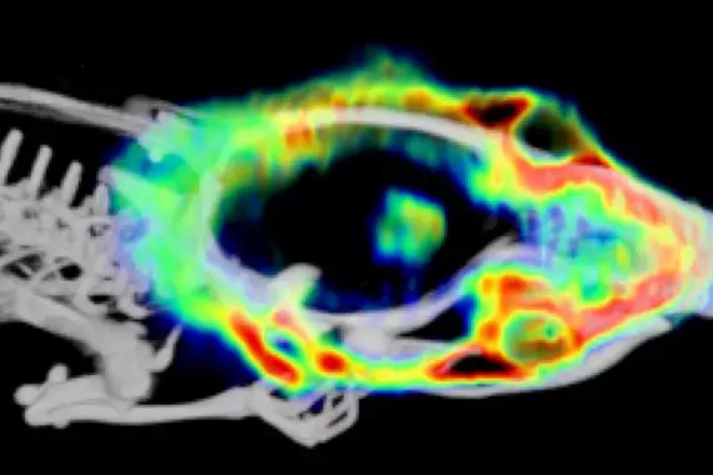
Fluorine-18-labelled folate PET/CT 3D fusion image of a rat subject with a glioma visible in the central region of the brain. Credit: Maxwell Miner, UNIVERSITY OF TURKU.
Experts recently discovered that folate-based radiopharmaceuticals have promising potential in detecting and treating deadly brain tumors.
According to researchers involved in the work, gliomas—a deadly group of brain tumors that are difficult to treat—have increased folate receptor expression, meaning they also show increased uptake of folate-based radiopharmaceuticals on PET imaging. This was discovered in both animal and human subjects with gliomas when the team injected the folate analogue 1,4,7-triazacylononane-1,4,7-triacetic acid-conjugated folate radiolabeled with aluminum fluoride-18 ([18F]FOL).
Experts involved in the study, which took place at the Turku PET Center at the University of Turku in Finland, hope that their discovery will lead to improved detection and targeted treatments of gliomas in the future.
”Prior to this discovery, the presence of folate receptors and their increased presence in gliomas had not been recognized, and thus they have not yet been used for imaging nor treatment purposes,” explained Maxwell Miner, a doctoral researcher at the Turku PET Center.
Initially, the group tested folate-based injections on rat models. The rats were imaged via contrast-enhanced MRI prior to PET imaging and were later divided into two groups—one that underwent folate-based PET imaging ([18F]FOL ) and one that underwent standard 18-FDG PET imaging. They were imaged at 19 and 32 days following glioma grafting.
Imaging showed an increase of [18F]FOL tumor-to-brain uptake ratio throughout the duration of the study, significantly higher uptake in comparison to the 18-FDG group. When tested on human subjects, similar folate receptor expression was observed.
“Our results show an average of 100-fold increase in folate-based radiopharmaceutical accumulation in glioma tissue versus that of adjacent healthy brain tissue”, noted lead researcher Anne Roivainen, a professor at InFLAMES Research Flagship Center at the University of Turku.
The group is hopeful that their discovery will lead to folate receptor-targeted imaging and treatments for gliomas in the future.
Their research was published in Frontiers in Immunology.